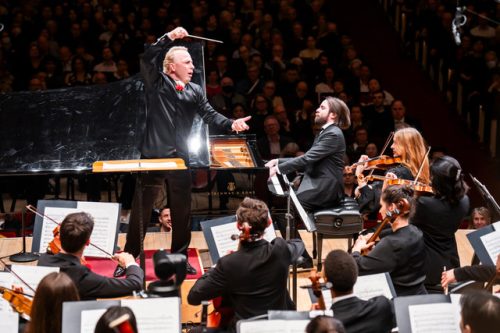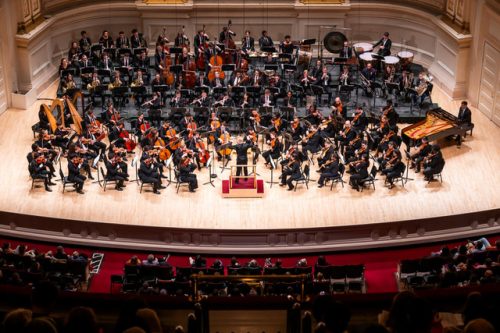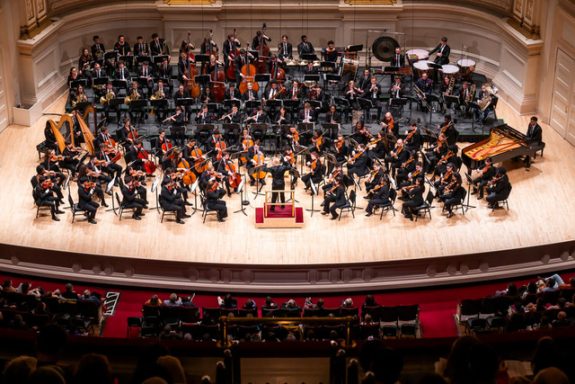 United States Gershwin, Shostakovich: Daniil Trifonov (piano), Alumni of the National Youth Orchestra of the United States of America / Yannick Nézet-Séguin (conductor). Carnegie Hall, New York, 14.3.2024. (RP)
United States Gershwin, Shostakovich: Daniil Trifonov (piano), Alumni of the National Youth Orchestra of the United States of America / Yannick Nézet-Séguin (conductor). Carnegie Hall, New York, 14.3.2024. (RP)

Gershwin – Concerto in F
Shostakovich – Symphony No.7 in C major, Op.60 ‘Leningrad’
The National Youth Orchestra of the United States of America (NYO-USA) is one of Carnegie Hall’s great success stories. Since it was founded in 2013, a thousand-plus extraordinarily talented musicians have participated in the free residency, working with leading professional orchestral players and world-renowned conductors. The NYO-USA’s annual concert is one of the most energized and inspiring musical events of the year.
Over a hundred NYO-USA alums have landed in the world’s top orchestras, while many of the more recent participants are studying in American conservatories. For the first time, alums of the program returned to Carnegie Hall to be a part of NYO-USA All-Stars. For one night only, under the baton of Yannick Nézet-Séguin, the impressive ensemble performed works by Gershwin and Shostakovich.
Hats off to Carnegie Hall for the canny programming which resulted in a full house for the concert. For many, the draw was Russian piano virtuoso Daniil Trifonov as soloist in Gershwin’s Concerto in F. For others, it was the novelty of this youthful, all-American orchestra performing Shostakovich’s ‘Leningrad’ Symphony.
The works also reflect on Carnegie Hall’s fabled past. The Gershwin received its world premiere in the hall in 1925, with Walter Damrosch conducting the New York Symphony and the composer as soloist. Toscanini conducted the Shostakovich Symphony’s New York premiere in the hall in 1942, just months after its first performance in Moscow.
This was, perhaps, not the most polished or penetrating reading of the two works, but they were exciting. The Shostakovich, in particular, provided the opportunity to experience some exceptionally stylish solo playing from the woodwinds and brass. Throughout, the first violins produced a silken sound that grabbed the listener. The cymbal and timpani players elevated their playing in the Shostakovich to the equivalent of a precision sport.
Trifonov has been playing the Gershwin a good bit. His take on it is highly personalized and a bit idiosyncratic, but the pianist’s virtuosity and drive make the music come alive. The lyricism was there throughout, as well as the verve. He ripped off the fast-paced octave scales in the final measures of the piece with equal parts of force and elegance.
Nézet-Séguin shaped the performance to the extent possible. He is not the first conductor to lean into the exuberance of an NYO ensemble. The piano undoubtedly could have been more prominent at times, but that had as much to do with Trifonov’s approach to the concerto as with attention to balance. The orchestra players, however, can swing with best of them. Especially beautiful was the solo trumpet accompanied by a trio of clarinets in the second movement.
Trifonov indulged the audience with a single encore, Young and Heyman’s pop standard, ‘When I Fall in Love’. He offered music that was simple, moving and perfect.

Shostakovich dedicated the Symphony No.7 to Leningrad, the city of his birth. It was completed when the city was under siege by the Nazi forces in World War II. When the 900-day blockade was lifted in on 27 January 1944, an estimated 1.5 million people, both civilian and military, had perished. Patriotic to its core, the symphony was popular during the war and its immediate aftermath, although the sentiment wore thin during the Cold War in the West. It is also long, with the average performance lasting about 75 minutes. For Nézet-Séguin, time was not of the essence, and his reading clocked in at closer to 90 minutes.
Musicologists have cast doubt as to the message Shostakovich intended to impart with the symphony, with satire and cynicism replacing heroism in some minds. This switch was evident in Nézet-Séguin’s approach to the piece, and it was most pronounced in the first movement when the lower brass played with an enormous swagger that resounded with sardonic humor. Lyricism, especially from the strings, and wit yielded to fever-pitched sounds of victory in the symphony’s final bars. Nézet-Séguin paced a relentless march to the inevitable C major chords that resounded through the hall and brought the audience to its feet.
NYO-USA, as well as NYO2 and NYO Jazz, will gather again this summer from 20 July to 15 August. The NYO-USA will perform its Carnegie Hall concert on 5 August with conductor Marin Alsop and pianist Jean-Yves Thibaudet, followed by a tour of South America.
Rick Perdian
This performance will be added to CarnegieHall+ soon. For more information, click here.
